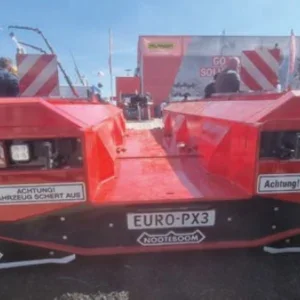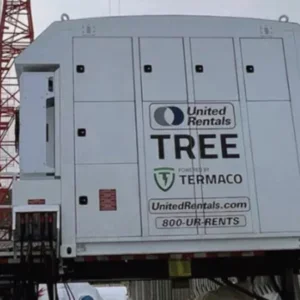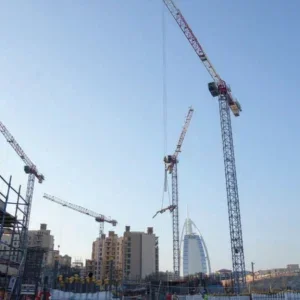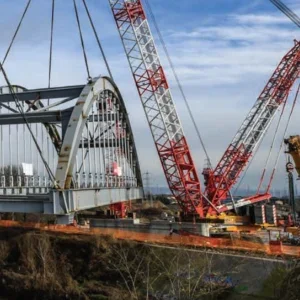Since the strict STGOroad regulations came in to effect two years ago in Europe, the most popular size of all-terrain crane tyres, 445/95 R25 16.00, have been scarce. “There was an increase in demand to fit tyres specifically for crane operations,”says a spokesman for Michelin, one of the largest crane tyre manufacturers.
Not all crane tyres are hard to find.
It would appear that smaller-volume products, such as rough terrain crane tyres, and higher-volume but more mainstream truck tyres for boom trucks are not so difficult to find, according to Jason Bonner, Terex-Waverley strategic materials coordinator.
With most all-terrain cranes going to Europe, the tyre shortage is primarily a European problem. “We have always been able to use all our cranes,”says a spokesperson forBelgian crane rental firmMichielsens. “But the fact remains that this shortage of tyres demands careful planning. It puts extra stress on the company because tyres are such a vital part of our machines and therefore our services.”
Liebherr Ehingen’s sales managing director Hans-Georg Frey reported in June that tyres have become the limiting factor for the company’s German all-terrain crane factory production line, despite great, and rising, demand. “Component bottlenecks, particularly for tyres, mean that we cannot currently increase production any further,” he said.
For the rest of the year, with rising demand from the equipment manufacturers, the situation looks set to get worse before it gets better.
There are three principal all-terrain tyre manufacturers: Bridgestone, which makes its tyres in Japan, Michelin, whose crane tyres are French, and Goodyear, which makes crane tyres in Luxembourg. Bridgestone makes several hundred thousand crane tyres per year, according to Bridgestone off-road tyre European marketing manager Naji Kamouh, 80% of which is the 16.00 tyre, also known as the 445/95 R25. Michelin is the other main producer, and in September is switching all its crane tyre production to its new X-tyre.
The manufacturers split the stream of tyres between the crane manufacturers and the aftermarket – tyre dealers and brokers.
Kamouh estimates that the company could sell between 20% and 25% more tyres if they were available.
“We have been at 100% production for the past three years, and see no change for the next couple of years,” Shakespeare at Goodyear says.
Bridgestone’s two tyre factories in Japan are currently being extended, which will gradually increase supply at the end of this year and the beginning of next. That should reduce the waiting times for a new set of tyres, which Kamouh says can last as long as two months at the moment. “When they were in stock in 2004, you could get tyres in 24-48 hours. Now you can go up to a couple of months to get tyres. Usually dealers do not hold so much stock because they stock many different lines, and do not have space to keep tyres. The manufacturers store them instead.”
A Michelin spokesperson said that the company is shifting earthmover tyre production to a recently-expanded factory in Lexington, Kentucky, USA, and opening a plant in Campo Grande, Brazil, both of which will help free up space for crane tyres.
Goodyear has a new design of crane tyre on the books, but it is still a few years away from marketing because there is no spare production capacity. It currently sells the GB2B crane tyre, which the company recommends should cool off for 30 minutes after three hours’ or 210km (130 mi) of road travel.
Tony Shakespeare, Goodyear off-road tyre product manager, says that he is not concerned about Indian or Chinese competition supplying tyres on the European market. “It is not so easy to develop a good crane tyre. This is a very specialised market.”
Since 2004, Bridgestone prices have risen between 15% and 20% because of higher raw material costs, particularly steel, natural rubber and oil, Kamouh says. “Those price increases are looking to continue,” he says, adding that these increases were not due to demand.
The aftermarket
Desperate customers are turning to the aftermarket, which accounts for about 10% of the entire market, according to Kamouh.
“Tyres can be found. It’s not like if we have stopped supply,” Kamouh says. “The thing is that since 2004 we have been supplying about the same quantity, but demand has gone up.
“There are some customers who have no choice.” “They have to buy tyres whatever the cost. Then the dealer is in a strong position to raise prices. In some cases contracts with big crane rental companies will be arranged with a price that is fixed for a year or two.”
Says Goodyear’s Tony Shakespeare: “Some products are being offered by brokers at absolutely ridiculous prices. It is a better business to be in than diamonds or gold. We don’t supply to brokers. They cast their net and buy through wherever they can. Where we supply to end users or dealers, we make sure that they are bona-fide dealers that work within the system.”
The shortage translates into delays for some customers. “Our main supplier cannot deliver what he wants because of limited delivery-quotes,”Michielsens says. “Our supplier can deliver tyres to our company. But sometimes the delivery dates are up to two months.”
Instead of buying a new tyre, an all-terrain crane operators are retreading used tyre to get a few more miles out of an older set.
“We have been using tires in situations that we would not really make it, however only in places that equipment will run very little,” says Patrícia Silva dos Santos of Brazilian crane rental firm Locar.
“Retreading facilities are taking business, but even so, we still cannot satisfy the global demand,” Shakespeare says.
“It’s not that we don’t recommend it,”Kamouh at Bridgestone said. “If the casing allows it, it is okay.”
“We have all our tyres retreaded,”says Michielsens. “Here lies the problem of the tyres market. The companies that specialize in retreading are charging hugh rates and have delivery dates
up to seven weeks.”






